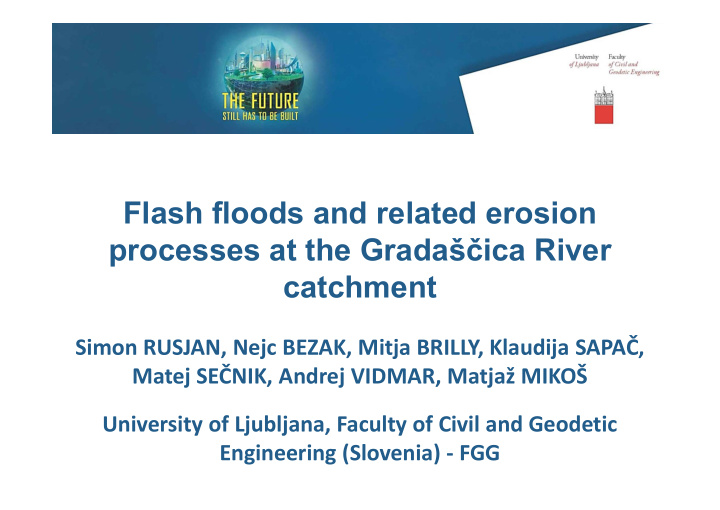



Flash floods and related erosion processes at the Gradaščica River catchment Simon RUSJAN, Nejc BEZAK, Mitja BRILLY, Klaudija SAPAČ, Matej SEČNIK, Andrej VIDMAR, Matjaž MIKOŠ University of Ljubljana, Faculty of Civil and Geodetic Engineering (Slovenia) - FGG
Overview Repeated Terrestrial Laser Scanning (TLS) was combined with hydrological monitoring (rainfall, runoff, sediment transport) in order to identify geomorphic changes and sediment transport processes in the headwater Gradaščica River catchment and Kuzlovec torrent subcatchment. One specific extreme rainfall event caused intense soil erosion and sediment transport processes. These kind of extreme events can cause large economic loss and endanger human lives. 2. 12. 2016 2
Location 2. 12. 2016 3
Kuzlovec torrent sub-catchment 0.71 km 2 Catchment area Elevation range (min, max, average) 394 m; 847 m; 631 m a.s.l Slope (max, average) 46.5° (105.3%); 27.3° (51.6%) Exposition SW Length of the main stream Annual precipitation 1600-1800 mm Maximum water discharge measured N/A Minimum water discharge measured N/A broad-leaved forest, mixed forest, land Vegetation cover / land cover / land use principally occupied by agriculture, with significant areas of natural vegetation limestone, dolomite, sandy slate, Geology Groden layers – red sandstone, alevrolite, slate and conglomerate Soils (FAO type) Rendzic Leptosol 2. 12. 2016 4
Hydro-meteorological measurements 2. 12. 2016 5
Terrestrial Laser Scanning (TLS) Based on the points clouds (several million points) the DTMs for years 2013, 2014 and 2015 with 0.05 m grid cell were determined. An important step of the DTM pre-processing was removal of large wood. Point cloud Classified point cloud excluding Ground points vegetation 2. 12. 2016 6
TLS DTM comparison was performed on a smaller section of the Kuzlovec torrent. 2. 12. 2016 7
Hydro-meteorological situation in the torrent 2. 12. 2016 8
August 2014 extreme event http://ksh.fgg.uni-lj.si/avp/DisCrniVrh/ 2. 12. 2016 9
August 2014 extreme event Tipping bucket rain gauges measured between 110 and 140 mm in 9 hours, which correspond to the return period between 100 and 250 years. Minute rainfall intensities measured by disdrometer were up to 300 [mm/h]. More than 50 shallow landslides were triggered. About 50 km of roads were damaged, 4 bridges collapsed. Flood peak at the Gradaščica River water station: Q = 69 [m 3 /s] ( ~ 25-year return period). 2. 12. 2016 10
August 2014 extreme event 2. 12. 2016 11
Comparison between the derived DTMs 2. 12. 2016 12
Comparison between the derived DTMs 2. 12. 2016 13
Comparison between the derived DTMs 2. 12. 2016 14
Rainfall event in October 2014 SSL Discharge 900 80 800 70 700 60 600 Discharge [m 3 /s] 50 500 SSL [t] 40 400 30 300 20 200 10 100 0 0 28.9.2014 8.10.2014 18.10.2014 28.10.2014 7.11.2014 17.11.2014 27.11.2014 Date 2. 12. 2016 15
Rainfall event in October 2014 Sediment deposits along the Gradaščica River channel after the October 2014 flood event (left-suspended sediment deposition on the floodplain; right – excavation of the deposited material). 2. 12. 2016 16
Rainfall event in October 2014 The recurrence interval of the October floodwave (peak Q = 72 m 3 /s ≈ Q 50 ). The total amount of the transported suspended sediment material during the October and November 2014 events was about 21,000 t. The specific sediment yield of about 2.6 t/ha. The estimated total volume of the suspended material transported along the Gradaščica River channel was approximately 8000 m 3 . 2. 12. 2016 17
Sediment deposition in Ljubljanica river channel Estimation: 40.000 m 3 of deposited sediments. 2. 12. 2016 18
Conclusions The extreme August and October 2014 flash flood triggered by the rainfall event with a return period of over 100 years caused extensive damage of infrastructure and had a great impact on the geomorphic conditions in the rive channels. Most of the local deposition areas can be attributed to the sediment delivery from small local side tributaries (gullies) whereas the erosion areas detected near the stream channel or in the channel itself are mostly caused by the water flow drag force. A particular torrential channel characteristic is the shifting and degradation of the Kuzlovec torrent channel bed, which is, in some short sub-reaches, eroded to the bedrock. 2. 12. 2016 19
Conclusions The sediment budget due to an extreme flash flood can be more than a magnitude larger than the mean annual budget during average hydrological years. The unit stream power for the investigated area of the Kuzlovec torrent was assessed to be approximately 500 W/m 2 during the August 2014 extreme event (the unit stream power was well above the often used threshold where significant geomorphic changes can occur). High amounts of suspended sediments can be transported along the Gradaščica river channel). 2. 12. 2016 20
Recommend
More recommend